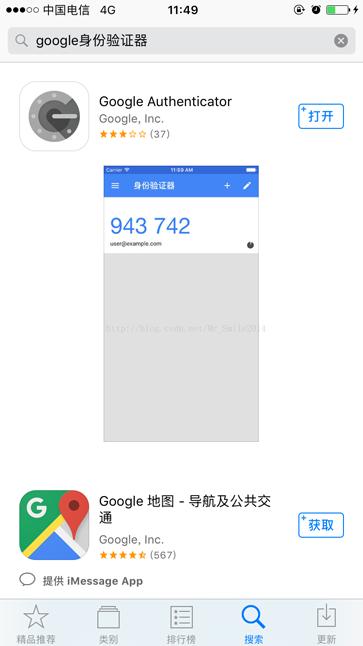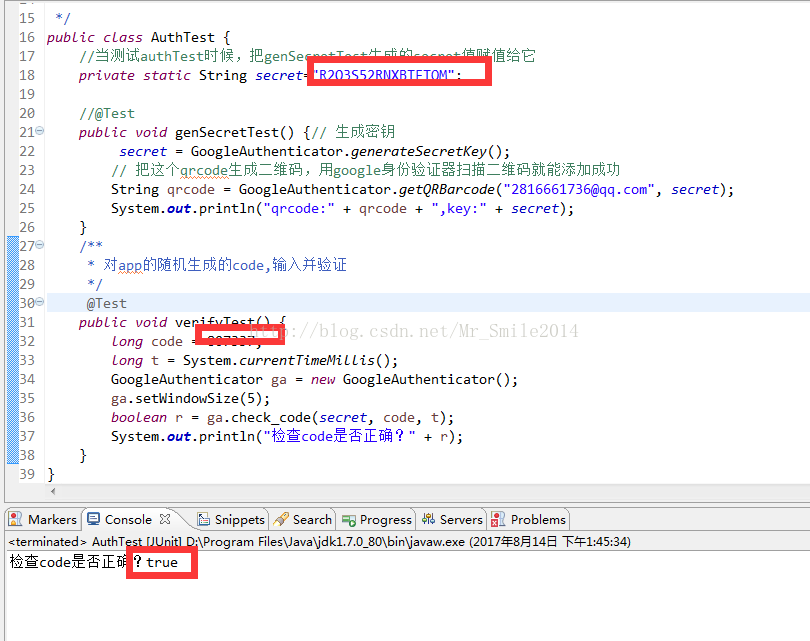谷歌Google验证
最近有用户反应我们现有的短信+邮件验证,不安全及短信条数限制和邮件收验证码比较慢的问题,希望我们也能做一个类似银行动态口令的验证方式。经过对可行性的分析及慎重考虑,可以实现一个这样的功能。
怎么实现呢,是自己开发一个这样的app?这样成本太高了,为了节约成本,我们使用互联网使用比较多的google身份验证器。使用它,我们只需要开发服务端就可以了。
google身份验证器的原理是什么呢?客户端和服务器事先协商好一个密钥K,用于一次性密码的生成过程,此密钥不被任何第三方所知道。此外,客户端和服务器各有一个计数器C,并且事先将计数值同步。进行验证时,客户端对密钥和计数器的组合(K,C)使用HMAC(Hash-based Message Authentication Code)算法计算一次性密码,公式如下:
|
1
|
HOTP(K,C) = Truncate(HMAC-SHA-1(K,C))
|
上面采用了HMAC-SHA-1,当然也可以使用HMAC-MD5等。HMAC算法得出的值位数比较多,不方便用户输入,因
此需要截断(Truncate)成为一组不太长十进制数(例如6位)。计算完成之后客户端计数器C计数值加1。用户将这一组十
进制数输入并且提交之后,服务器端同样的计算,并且与用户提交的数值比较,如果相同,则验证通过,服务器端将计数值
C增加1。如果不相同,则验证失败。
|
package com.qkwl.common.google;
import java.security.InvalidKeyException; import javax.crypto.Mac; import org.apache.commons.codec.binary.Base32; /** // taken from Google pam docs - we probably don't need to mess with these int window_size = 3; // default 3 - max 17 (from google docs) /** /** SecureRandom sr = null; } catch (NoSuchAlgorithmException e) { /** /** // convert unix msec time into a 30 second "window" for (int i = -window_size; i <= window_size; ++i) { private static int verify_code(byte[] key, long t) throws NoSuchAlgorithmException, InvalidKeyException { SecretKeySpec signKey = new SecretKeySpec(key, "HmacSHA1"); int offset = hash[20 - 1] & 0xF; // We're using a long because Java hasn't got unsigned int. truncatedHash &= 0x7FFFFFFF; return (int) truncatedHash; |
测试代码:
|
/** /** /** /** } |
具体使用方式(iOS演示):
第一步:进入iphone的appstore,在搜索框中输入google身份验证器,如下图:

选择上图中的google authenticator 并安装。
第二步:运行下面链接中下载的demo中的AuthTest的genSecretTest方法,控制台打印的结果如下图:

key:为app与服务端约定的秘钥,用于双方的认证。
qrcode:是app扫码能够识别的就是二维码值,把它生成二维码如下图:

第三步:打开google authenticator app软件选择扫描条形码按扭打开相机对二维码扫描加入账号,如下图:

第四步:把app中的数字,在AuthTest的verifyTest进行验证,如下图:

通过上面给大家分享了google身份认证器服务端key的生成和它生成的随机密码的验证。
谷歌Google验证相关推荐
- 使用C++实现谷歌身份验证器(Google Authenticator)
使用C++实现谷歌身份验证器(Google Authenticator) 本机环境: windows10 x64位运行环境 1.进入网站:http://slproweb.com/products/Wi ...
- 【SpringBoot】61、SpringBoot中使用谷歌身份验证器(Google Authenticator)实现二步身份验证
Google 身份验证器 Google Authenticator 是谷歌推出的基于时间的一次性密码 (Time-based One-time Password,简称 TOTP),只需要在手机上安装该 ...
- 【Django】使用谷歌身份验证Google authenticator
1.说明 为了安全,可以使用Google authenticator作为二次验证的条件,使用起来很简单,只需要使用Google authenticator APP扫描一下二维码即可得到六位数验证码,验 ...
- Google authenticator 谷歌身份验证,实现动态口令
Google authenticator 谷歌身份验证,实现动态口令 google authenticator php 服务端 使用PHP类 require_once '../PHPGangsta/G ...
- 使用谷歌身份验证器(Google Authenticator)保护你的后台
为何要使用谷歌身份验证器 普通的网站只使用账号.密码.图形验证码进行后台登录.根据我(作为站长)多年的经验来看,这种方式安全性很低,尤其是使用 http 协议,明文的帐号和密码相当于在网络上裸奔.如果 ...
- Google Authenticator windows client 谷歌身份验证器 windows 电脑端
谷歌身份验证器现在有安卓客户端和ios客户端,本人开发了一个windows客户端,基于 .NETFramework v4.7 开发,已在 github 上开源,可以在 github 上直接下载. gi ...
- 使用谷歌身份验证器增强SSH安全
一般大家都是使用账号和密码远程SSH登录管理服务器.但SSH账号和密码很容易泄露,或者经常遭遇暴力破解.咨询过前同事赛赛,他们目前使用了谷歌身份验证器.查看了谷歌身份验证器的github和其它网上文档 ...
- Laravel项目+Google验证器
1.首先要在你的Laravel项目中安装Google验证器插件.二维码生成器插件,执行命令如下: # Google验证器插件安装命令: composer require "earnp/lar ...
- Thinkphp5添加谷歌双重验证
本文作者:陈进坚 博客地址:https://jian1098.github.io CSDN博客:https://blog.csdn.net/c_jian 联系方式:jian1098@qq.com 说明 ...
- 如何为SSH登录建立双因子验证机制(谷歌身份验证器)?
前言 默认情况下,SSH已经在远程机器之间使用安全的数据通信;但是如果你想为自己的SSH连接添加另外某种安全层,可以添加谷歌身份验证器(Google Authenticator)双因子验证模块,该模块 ...
最新文章
- 学习笔记--zabbix
- 再谈访问修饰符——读《你必须知道的.net》
- javascript console自动点击页面元素
- [Swift]LeetCode1147. 段式回文 | Longest Chunked Palindrome Decomposition
- Vue中计算属性与class,style绑定
- 宝塔自助建站系统源码v8.0
- (二)GitHub使用随记
- 聊聊那些知识管理软件
- VS(Visual Studio)间接引用
- u-boot与linux下网卡MAC地址的更改
- 2018年腾讯实习生招聘模拟笔试:硬币组合-个人思路及代码
- 杀毒软件会从哪些方面对计算机进行保护作用(360杀毒软件)
- webuploader 手机端上传图片默认打开相机 改为选择相册
- iOS视频转码 mov 转 mp4
- java及vue实现获取电脑打印机及打印功能
- 【GD32】GD32设置看门狗
- 批处理获取整台计算机的盘符,可以用批处理的方法更改盘符吗?
- 【PAT天梯赛练习集L2-1】紧急救援——SPFA
- android判断主线程_惊天秘密!从Thread开始,揭露Android线程通讯的诡计和主线程的阴谋...
- golang io.Reader和io.Writer
